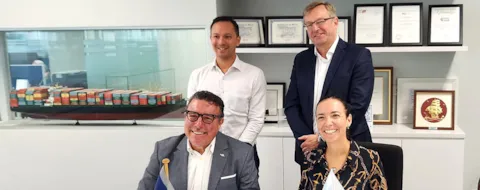DNV and AL Group to cooperate on CCS feasibility study
Classification society DNV has entered into a Joint Development Project (JDP) with AL Group and its Singapore company Asiatic Lloyd Maritime LLP to explore the feasibility of carbon capture and storage (CCS) on board AL’s 7,100TEU containership and Kamsarmax bulk carrier newbuildings.
Under the JDP, DNV will cooperate with AL on a techno economic study of CCS on board the vessels using DNVs FuelPath to assess the economic potential of the different fuel and technology strategies. The model will reflect a range of fuel and CO2 price scenarios and future decarbonization requirements, aligned with AL’s own net zero ambitions.
“At AL Group we continue with our unwavering journey on sustainability and efforts on decarbonization. This Joint Development Project with DNV allows us to explore actively, the adoption of carbon capture technology for our future fleet, while fortifying our commitment to environmental stewardship, emissions reduction, and innovation”, said Tonci Zdunic, Group Fleet Director of AL Group.
Adding to this, Cristina Saenz de Santa Maria, Regional Manager South East Asia, Pacific & India, Maritime at DNV said, “It’s becoming increasingly important for shipowners to look ahead and embark on a decarbonization strategy that allows for regulatory compliance and optimized operations. To this effect, we are delighted to be partnering with AL Group to explore cost-effective fuel strategies that would support their net zero ambitions. Backed by DNV’s experienced global network and team of experts in the Maritime Decarbonization & Autonomy Regional Centre of Excellence in Singapore, we are in a prime position to help the industry navigate the maritime energy transition in a safe and efficient manner.”
DNV published new guidelines for the safe installation of onboard carbon capture and storage (OCCS) system on board ships earlier this month. This comes amid growing pressure on the shipping industry to develop effective technologies to reduce emissions by 2030.
